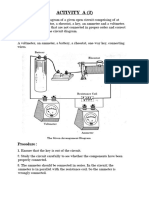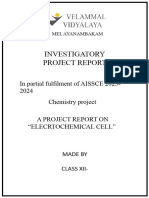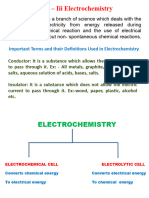0% found this document useful (0 votes)
2K views12 pagesElectrolytic Cell
An electrolytic cell uses electrical energy to drive non-spontaneous redox reactions through the application of a voltage. It consists of an electrolyte and two electrodes - a cathode and anode. When a voltage is applied, ions in the electrolyte are attracted to electrodes of opposite charge, allowing redox reactions to occur. Galvanic cells, also called voltaic cells, derive electrical energy from spontaneous redox reactions within the cell. A primary cell is designed to be used once and discarded, unlike a rechargeable secondary cell. The document then discusses experiments examining predictions of a chemical reaction model for a lemon battery. Adding zinc sulfate reduced voltage as predicted, while copper sulfate did not affect it.
Uploaded by
abcCopyright
© © All Rights Reserved
We take content rights seriously. If you suspect this is your content, claim it here.
Available Formats
Download as DOCX, PDF, TXT or read online on Scribd
0% found this document useful (0 votes)
2K views12 pagesElectrolytic Cell
An electrolytic cell uses electrical energy to drive non-spontaneous redox reactions through the application of a voltage. It consists of an electrolyte and two electrodes - a cathode and anode. When a voltage is applied, ions in the electrolyte are attracted to electrodes of opposite charge, allowing redox reactions to occur. Galvanic cells, also called voltaic cells, derive electrical energy from spontaneous redox reactions within the cell. A primary cell is designed to be used once and discarded, unlike a rechargeable secondary cell. The document then discusses experiments examining predictions of a chemical reaction model for a lemon battery. Adding zinc sulfate reduced voltage as predicted, while copper sulfate did not affect it.
Uploaded by
abcCopyright
© © All Rights Reserved
We take content rights seriously. If you suspect this is your content, claim it here.
Available Formats
Download as DOCX, PDF, TXT or read online on Scribd
/ 12





























































































